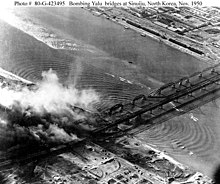Sino-Korean Friendship Bridge
| Sino–Korean Friendship Bridge | |
|---|---|

View from Dandong, China
|
|
| Coordinates | 40°6′54″N 124°23′33″E / 40.11500°N 124.39250°ECoordinates: 40°6′54″N 124°23′33″E / 40.11500°N 124.39250°E |
| Carries | road and rail traffic |
| Crosses | Yalu River |
| Locale | Sinŭiju, North P'yŏngan, North Korea |
| Official name |
中朝友谊桥 (Chinese) 조중우의교 (Korean) |
| Other name(s) | Sino-Korean or China–Korea Friendship Bridge |
| Characteristics | |
| Material | Iron |
| Total length | 940.8 m (3,087 ft) |
| Sino-Korean Friendship Bridge | |||||||||||||||||

Aerial photograph taken in November 1950 during air attacks by US bombers shows damage to the Yalu River bridges
|
|||||||||||||||||
| Chinese name | |||||||||||||||||
|---|---|---|---|---|---|---|---|---|---|---|---|---|---|---|---|---|---|
| Traditional Chinese | 中朝友誼橋 | ||||||||||||||||
| Simplified Chinese | 中朝友谊桥 | ||||||||||||||||
|
|||||||||||||||||
| Korean name | |||||||||||||||||
| Chosŏn'gŭl | 조중우의교 | ||||||||||||||||
| Hancha | 朝中友誼橋 | ||||||||||||||||
|
|||||||||||||||||
| Transcriptions | |
|---|---|
| Standard Mandarin | |
| Hanyu Pinyin | Zhōng Cháo yǒuyì qiáo |
| Wade–Giles | Chung Ch'ao yu-i ch'iao |
| IPA | [ʈʂʊ́ŋ ʈʂʰǎu̯ i̯òu̯î tɕʰi̯ǎu̯] |
| Yue: Cantonese | |
| IPA | [tsʊ́ŋ.tɕʰȉːu jɐ̬ujìː kʰȉːu] |
| Jyutping | Zung1 ciu4 jau5 ji6 kiu4 |
| Transcriptions | |
|---|---|
| Revised Romanization | Jo-Jung u-ui gyo |
| McCune–Reischauer | Cho-Chung u-ǔi-kyo |
The Sino–Korean Friendship Bridge or China–North Korea Friendship Bridge is a bridge across the Yalu River on the China–North Korea border. It connects the cities of Dandong, China and Sinuiju, North Korea, but pedestrians are not allowed to cross. One of the few ways to enter or leave North Korea, it carries automobile and rail traffic.
It was renamed to its current name from the "Yalu River Bridge" in 1990. That bridge was constructed by the Imperial Japanese Army between April 1937 and May 1943, during their occupation of Korea and northeast China. Further downstream, a third bridge began construction in October 2010.
About 60 m (66 yd) downstream are the remains of an older bridge constructed between May 1909 and October 1911. It was an 944.2 m (3,098 ft) iron truss bridge with 12 spans on stone piers. The fourth span was a swing bridge that could be opened with a 90° horizontal rotation to allow easy navigation for tall ships. Both bridges were bombed by American aircraft during the Korean War. From November 1950 to February 1951, the United States used B-29 heavy bombers, and F-80 fighter-bombers to repeatedly attack the bridges in an attempt to cut off Chinese supplies to the North Koreans. The bridges were repeatedly repaired. The 1911 bridge was left destroyed and only the newer 1943 bridge repaired and used at the end of the war. The North Koreans claimed that they did not want to rebuild the broken bridge so that the U.S. could not deny they destroyed it. Four spans of the old bridge remained on the Chinese side of the river, giving it the name "Broken Bridge" (断桥 Duàn qiáo).
...
Wikipedia
